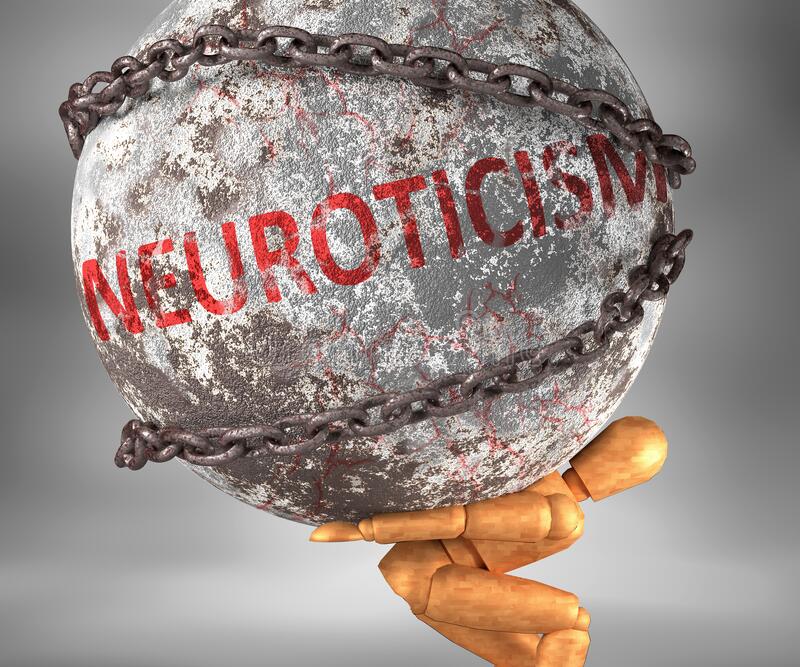The Big Five Personality Traits
Many contemporary Personality Psychologists believe that there are five basic dimensions of Personality, often called The Big Five Personality Traits: Openness, Conscientiousness, Extraversion, Agreeableness, and Neuroticism.

To remember the Big Five traits, you might find the acronym OCEAN (Openness, Conscientiousness, Extraversion, Agreeableness, and Neuroticism) helpful. Or you could use CANOE (for Conscientiousness, Agreeableness, Neuroticism, Openness, and Extraversion).
Openness
People who like to learn new things and enjoy new experiences usually score high in openness. Exposure also includes traits like being insightful, imaginative, and having various interests.
Conscientiousness
People with a high degree of Conscientiousness are reliable and prompt. Traits include being organized, methodic, and thorough.
Extraversion
Extraverts get energy from interacting with others, while introverts get points from within themselves. Extraversion includes energetic, talkative, and assertive traits.
Agreeableness
These individuals are friendly, cooperative, and compassionate. Conversely, people with low Agreeableness may be more distant. Traits include being kind, affectionate, and sympathetic.
Neuroticism
Neuroticism is also sometimes called Emotional Stability. This dimension relates to one’s emotional Stability and degree of negative emotions.
People who score high on Neuroticism often experience emotional instability and negative emotions. Traits include being moody and tense.
The Big Five is not a Psychological Theory.
Collectively, the Big Five is a taxonomy of personality traits. A coordinate system that maps which features go together as a description or rating is used to help understand and predict success in social, academic, and professional circumstances.
It is an empirically based phenomenon, not a personality theory, and was discovered through a statistical procedure called factor analysis.
It was used to analyze how various personality trait ratings correlate in humans.
The original derivations relied heavily on American and Western European samples, and researchers are still examining the extent to which the Big Five structure generalizes across cultures.
The Big Five/Five-Factor Model
Some researchers use the label Five-Factor Model instead of Big Five. In scientific usage, the term “model” can refer to either a descriptive framework of what has been observed or a theoretical explanation of causes and consequences. The Five-Factor Model is a model in the descriptive sense only.
The model has been criticized for its limitations concerning the number of personality traits evaluated and for being data-driven rather than based on a psychological theory.
Proponents of the Five-Factor model argue that it delivers consistent results and that a personality description must precede, not follow a personality theory.
The term “Big Five” was coined by Lew Goldberg and was initially associated with studies of personality traits used in natural language. It has been more commonly associated with studies of features using personality questionnaires.
The two research traditions yielded largely consonant models (in fact, this is one of the strengths of the Big Five/Five-Factor Model as a common taxonomy of personality traits. In current practice, the terms are often used interchangeably.
A subtle but sometimes important area of disagreement between the linguistic and questionnaire approaches is over the definition and interpretation of the fifth factor, called Intellect/Imagination by many lexical researchers, and Openness to Experience by many questionnaire researchers.
The Big Five are best understood as a model of reality-based person perception. In other words, it is a model of what people want to know about one another.
Personality Traits Are Not Correlated
Scores on the Big Five traits are mostly independent. That means that a person’s standing on one feature tells very little about their standing on the other characteristics of the Big Five. For example, a person can be extremely high in Extraversion or either high or low in Neuroticism.
Similarly, a person can be low in Agreeableness or either high or low in Conscientiousness. Thus, in the Five-Factor Model, you need five scores to describe most of an individual’s Personality.
Personality Temperaments, Traits, and Types
Personality Temperaments, Personality Traits, and Personality Types are used in Psychology to discuss a person’s Personality, a collection of Emotions, Perceptions, and Actions that interact with each other, regulate themselves, and shape a dynamic system that forms a person’s Behavioral Patterns.
Your inherited traits (your personality Temperance) and acquired traits (such as education, socialization, and other various pressures and aspects) form your Personality.
A Personality Type identifies a specific collection of Traits, both learned and natural, that comprise a broad, general Personality Classification—a way of labeling a collection of traits and behaviors.
A Personality Trait remains consistent and stable over time, which means you exhibit the same pattern across different situations and throughout your life.
Three criteria characterize Personality Traits: (1) consistency, (2) stability, and (3) individual differences. For example, if you are talkative at home, you also tend to be talkative at work. And if you were talkative at age 20, you would still be chatty at age 40.
Personality Temperament is your “Naturally Intuitive” biological Trait. These Traits are partly inherited from your genes and partially determined by your brainstem, which doesn’t change throughout your life. These are Natural Traits regarded as innate or inborn and not learned.
Your Personality Temperament is formed as an infant and is hard to modify, manipulate, or change because it is genetic. In some way or another, your inherited behavioral tendency will always be there.
Personality Traits are quantitative differences between people, and Personality Types are qualitative differences between people. The most crucial difference between the Trait Theory and the Type Theory is that the Type Theory views people’s characteristics as discrete categories, while the Trait Theory views these characteristics as a continuum.
For example, while a Type Theorist would claim that introverts and extraverts are two types of people, a Trait Theorist claims that extraversion is a gradient, and individuals can fall somewhere in the middle.
Your Temperaments, along with acquired Traits, form your Personality.
Extraversion as a Personality Trait
Extraversion is a Personality Trait that involves seeking fulfillment from sources outside the self. In everyday language, we often use the label introvert to describe people who are low in extraversion.
Still, personality researchers generally talk about low versus high extraversion rather than about introverts and extraverts.
Partly, that’s to avoid thinking of extraversion and introversion as personality types and to avoid the confusion that introversion is somehow the opposite of extraversion, which it isn’t.
Introverts fall at the lower end of the normal distribution of extraversion scores. While introverts may prefer fewer social interactions than extraverts, this does not mean they dislike interacting with other people altogether.
In addition, introverts may be less assertive than extroverts but aren’t necessarily nonassertive or submissive. People with more extraverted tendencies are often the center of attention — and like it that way. As a result, they thrive in social situations and seek social stimulation.
Learn more about Extraverion vs. Introversion.
Conscientiousness as a Personality Trait
Conscientiousness is the Personality Trait that reflects the tendency to be responsible, organized, goal-directed, and to adhere to rules and norms.
Comprising self-control, responsibility, and reliability, Conscientiousness is considered an outgrowth of emotional intelligence and self-regulation processes.
In a sense, Conscientiousness is a motive to be dependable and a desire to follow the rules. It influences how people set and keep long-range goals, deliberate over choices, behave cautiously or impulsively, and take obligations to others seriously.
People at the higher end of the spectrum may be at risk of perfectionism and workaholism and fare poorly under high-stress conditions.
People with low Conscientiousness may exhibit flexibility and spontaneity but tend to be unreliable and careless.
Conscientiousness has 49% genetic influence.
Learn more about Conscientiousness.
Agreeableness as a Personality Trait
The Openness to Experience Personality Trait is about seeking new experiences and intellectual pursuits. It’s about your willingness to try new things, vulnerability, and capability to think outside the box.
An individual high in Openness to Experience is likely someone who loves learning, enjoys the arts, engages in a creative career or hobby, and likes meeting new people.
An individual low in Openness to Experience probably prefers routine over variety, sticks to what they know, and prefers less abstract arts and entertainment.
The Openness to Experience Personality Trait has 57% genetic influence.
Learn more about Agreeableness.
Neuroticism as a Personality Trait

Neuroticism is characterized by sadness, moodiness, and emotional instability and is typically defined as a tendency toward anxiety, depression, self-doubt, and other negative feelings. A neurotic personality is characterized by persistent, often disproportionate, worrying, and anxiety.
People with high in this trait tend to experience mood swings, anxiety, irritability, and sadness. Conversely, those low in this trait are more stable and emotionally resilient.
Neuroticism can lead an individual to focus on and dwell on the negative aspects of a situation rather than the positives. As a result, they may become frustrated, furious, or angry as they struggle to cope with life stressors.
In contrast, people with low levels of Neuroticism find it easier to remain calm and are less affected by stressful events.
In addition, they can maintain a more proportionate perspective on events, which results in them often worrying less and experiencing lower stress levels.
People who are higher in Neuroticism tend to experience negative emotions more frequently than people who are low in Neuroticism. Their negative emotions tend to be more intense and last longer.
Openness as a Personality Trait
The Openness to Experience Personality Trait is about seeking new experiences and intellectual pursuits. It’s about your willingness to try new things, vulnerability, and capability to think outside the box.
An individual high in Openness to Experience is likely someone who loves learning, enjoys the arts, engages in a creative career or hobby, and likes meeting new people.
An individual low in Openness to Experience probably prefers routine over variety, sticks to what they know, and prefers less abstract arts and entertainment.
The Openness to Experience Personality Trait has 57% genetic influence.



